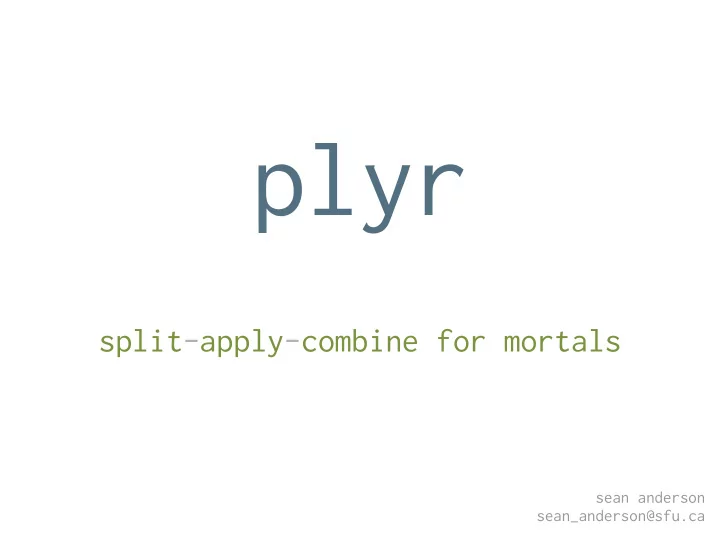

plyr split-apply-combine for mortals sean anderson sean_anderson@sfu.ca
why? 1. it’s everywhere 2. less code, simple syntax 3. it runs faster
look familiar? > d year count 1 2000 16 2 2000 4 3 2000 12 4 2001 15 5 2001 7 6 2001 12 7 2002 20 ...
why apply > for loop? less code subsetting saving results faster
> d year count 1 2000 16 2 2000 4 3 2000 12 4 2001 15 5 2001 7 6 2001 12 7 2002 20 ...
year mean 1 2000 10.66667 2 2001 11.33333 3 2002 13.66667
d.split <- split(d, d$year) results <- vector("list", length = length(d.split)) for(i in 1:length(d.split)) { temp <- d.split[[i]] temp.mean <- mean(temp$count) results[[i]] <- data.frame( year = unique(temp$year), mean = temp.mean) } do.call("rbind", results) inspired by Hadley Wickham: http://had.co.nz/plyr/
apply(array, 1 or 2, func) sapply(vector, func) lapply(list, func) tapply(vector, index, func) aggregate(object, by, func) ...
d.split <- split(d, d$year) result <- lapply(d.split, function(x) mean(x$count)) result <- unlist(result) result <- data.frame(year = unique(d$year), mean = result) row.names(result) <- NULL
enter plyr
ddply(d, "year", summarize, mean = mean(count))
d.split <- split(d, d$year) results <- vector("list", length = length(d.split)) for(i in 1:length(d.split)) { temp <- d.split[[i]] temp.mean <- mean(temp$count) results[[i]] <- data.frame( year = unique(temp$year), mean = temp.mean) } do.call("rbind", results)
output input ddply()
d - data frame l - list a - array _ - discard
ddply(data, "split", function)
ddply(d, "year", summarise, mean.count = mean(count))
year mean 1 2000 10.66667 2 2001 11.33333 3 2002 13.66667
ddply(d, "year", transform, total.count = sum(count))
year count total 1 2000 16 32 2 2000 4 32 3 2000 12 32 4 2001 15 34 5 2001 7 34 6 2001 12 34 7 2002 20 41 8 2002 15 41 9 2002 6 41
ddply(d, "year", function(x) { browser() }) Browse[1]> x year count 1 2000 16 2 2000 4 3 2000 12 Browse[1]> Q >
library(doMC) registerDoMC(2) # 2 cores ddply(d, f, .parallel = TRUE))
# fail gracefully: failwith(default, f)
remember 1. it’s everywhere 2. less code, simple syntax 3. it runs faster (sometimes) use it.
Recommend
More recommend